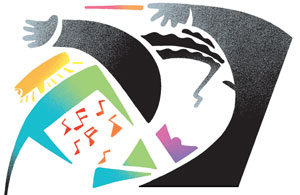Creative Thinking Tools I

While critical thinking plays by the rules, creative thinking is a rule breaker. While critical thinking focuses with tight precision, creative thinking reaches out with reckless abandon. To truly solve problems, you need to use both kinds of thinking in tandem. You can develop your creative thinking skills by forcing your brain out of accustomed grooves and into new territory.
Metaphorical Thinking
In school, we learned that a simile compares two things using like or as, and a metaphor equates two things directly:
Simile: My brother is like a Ford Mustang.
Metaphor: I am a Ford Pinto.
Similes and metaphors require us to think creatively: "How is my brother like a Ford Mustang?" (Perhaps he's sleek, strong, handsome, expensive, classic, desired. . . .) "Why am I a Ford Pinto?" (Perhaps I'm small, cheap, unassuming, old—and will explode if you hit me.) Similes and metaphors connect dissimilar things and require you to find the similarities. They force you out of linear thinking into divergent possibilities.
You can also use an analogy, which compares two different relationships, or a symbol, which uses an object or image to represent a concept.
Analogy: That senator pushes his legislation the way a used-car salesman pushes his fleet of flood-damaged vehicles.
Symbol: The senator's logo ought to be a check-engine light.
The analogy above provides a rich source of creative thinking: "How is the senator acting like a used-car salesman? How is the legislation like a fleet of flood-damaged vehicles? What does pushes mean in each context?" And the check-engine light means you have an unreliable vehicle in need of expensive repair (not a symbol that any senator would want).
Using Metaphorical Thinking (Google Doc)
Complete one or more of the following sentence patterns to spur creative thinking about your topic:
Simile: My topic is like something else.
Our office is like Edison's workshop.
Metaphor: My topic is something else.
This proposal is a "Dear John" letter.
Analogy: My topic does something like a different topic does something else.
My father enters a conversation like General Patton invades Italy.
Symbol: The physical representation of my topic should be an object or image .
The coat of arms of my family should be an overflowing laundry hamper.
Conceptual Blending
Conceptual blending takes metaphorical thinking to the next level. It forces you to blend two unrelated concepts together and work out the conflicts between them. The forced connection can produce new ideas that you never would have made through conventional thinking.
Conceptual Blending
Conceptual blending works by taking two dissimilar things, asking how they work together, and analyzing their connections. You can use conceptual blending to discover new solutions to problems.
How can our committee be more like a successful sports team?
Every member should understand his or her role.
There should be great leadership.
The group should have a defined goal.
The members should be dedicated to achieving that goal.
Members should maximize each other’s strengths and minimize each other’s weaknesses.
The members should execute a game plan.
Members should continue to learn and perfect their skills.
What could a PowerPoint presentation learn from a documentary film?
The subject needs to be relevant.
The opening needs to grab the audience’s attention.
There should be some arresting visuals.
The voices and language need to sound natural.
The transitions between scenes (slides) need to be seamless.
Additional perspectives about the topic make the presentation balanced and informative.
One person shouldn’t be talking the whole time.
The ending needs to include a call to action.
What qualities should an office share with a well-run restaurant?
The atmosphere should be inviting.
The customer service should be friendly and helpful.
The product and work flow should be efficient.
The seating should be conducive to communication.
Proper tools and updated technology should be available to do the job right.
The product should serve the customers’ needs and interests.
Creating a Conceptual Blend (Google Doc)
You can create a conceptual blend by completing one of the sentence patterns below:
-
How could my topic become more like something else?
How could my workplace become more like clothing?
-
What would a physical representation of my abstract topic look like?
What would a portrait of a payroll tax look like?
-
What features of an unrelated topic should my topic have?
What features of a movie director should a supervisor have?
-
How can my topic act more like something different?
How can an employee act more like a teacher?
Square Pegging

When the air-filtration system on Apollo 13 failed, the team at NASA poured a boxful of junk on a table and said, "These are the pieces that the astronauts can use to build a new filtration system. How are they going to do it?" None of those pieces were meant to do the job they needed to do, but creative thinking turned that junk into a working machine.
You may have heard that you can't fit a square peg in a round hole, but creative thinking loves just such a challenge. Square pegging forces you to imagine unusual uses for things, discovering creative possibilities. Ask yourself a square-pegging question and answer it in as many ways as possible.
How can a rowboat win an election?
Ferry in disenfranchised voters from the bayou.
Carry a voting machine out to island people who would otherwise not have a vote.
Allow your candidate to reenact Washington crossing the Delaware.
Compare the intelligence of the boat to that of an opponent.
Use the rowboat as a symbol—saving voters from a sinking ship.
Discover that your rival had been using the rowboat to smuggle contraband.
Film the rowboat in a "Viking Funeral" for the opposing party.
Obviously, some of those ideas are ridiculous, but the point is to force your brain out of its usual ruts to see a topic in an entirely new way.
Creating a "Square-Pegging" Question (Google Doc)
You can experiment with square pegging by completing the question below and answering it in as many ways as possible:
-
How could my topic do something it was never meant to do?
How could the office coffee maker ensure social justice?
Perspective Shifting
We naturally see topics from our own perspective, though we rarely consider how that perspective shapes our thinking. You can use a creative thinking strategy called perspective shifting to take a couple steps outside yourself and see your topic anew.
Start by listing facts about yourself, from broad to specific:
I am . . .
Health: Healthy
Age: 53
Gender: Male
Nationality: American
Ethnicity: Caucasian
Language: English
Location: Milwaukee
Occupation: Editor
Listing facts about yourself helps you understand your perspective on a topic:
"Given who I am, what do I naturally think of health insurance?"
Then you can change one or more facet of your perspective and reconsider the topic:
"If I were 27 instead of 53, what would I think of health insurance?"
"If I were female instead of male, what would I think of health insurance?"
"If I were a plumber instead of an editor, what would I think?"
"If I were sick, what would I think?"
Shifting Perspective (Google Doc)
Start by outlining your default perspective using these categories (adding or subtracting as you wish):
I am . . .
Health:
Age:
Gender:
Nationality:
Ethnicity:
Language:
Location:
Occupation:
Then name a topic and express your natural perspective on it. Afterward, change one fact about yourself and imagine how your perspective of the topic would shift. Change a second fact and shift perspective again.
You can use perspective shifting not only to understand a topic more fully, but also to empathize with people who are different from you. This technique also helps you understand the perspective of historical figures or characters in fiction or movies.